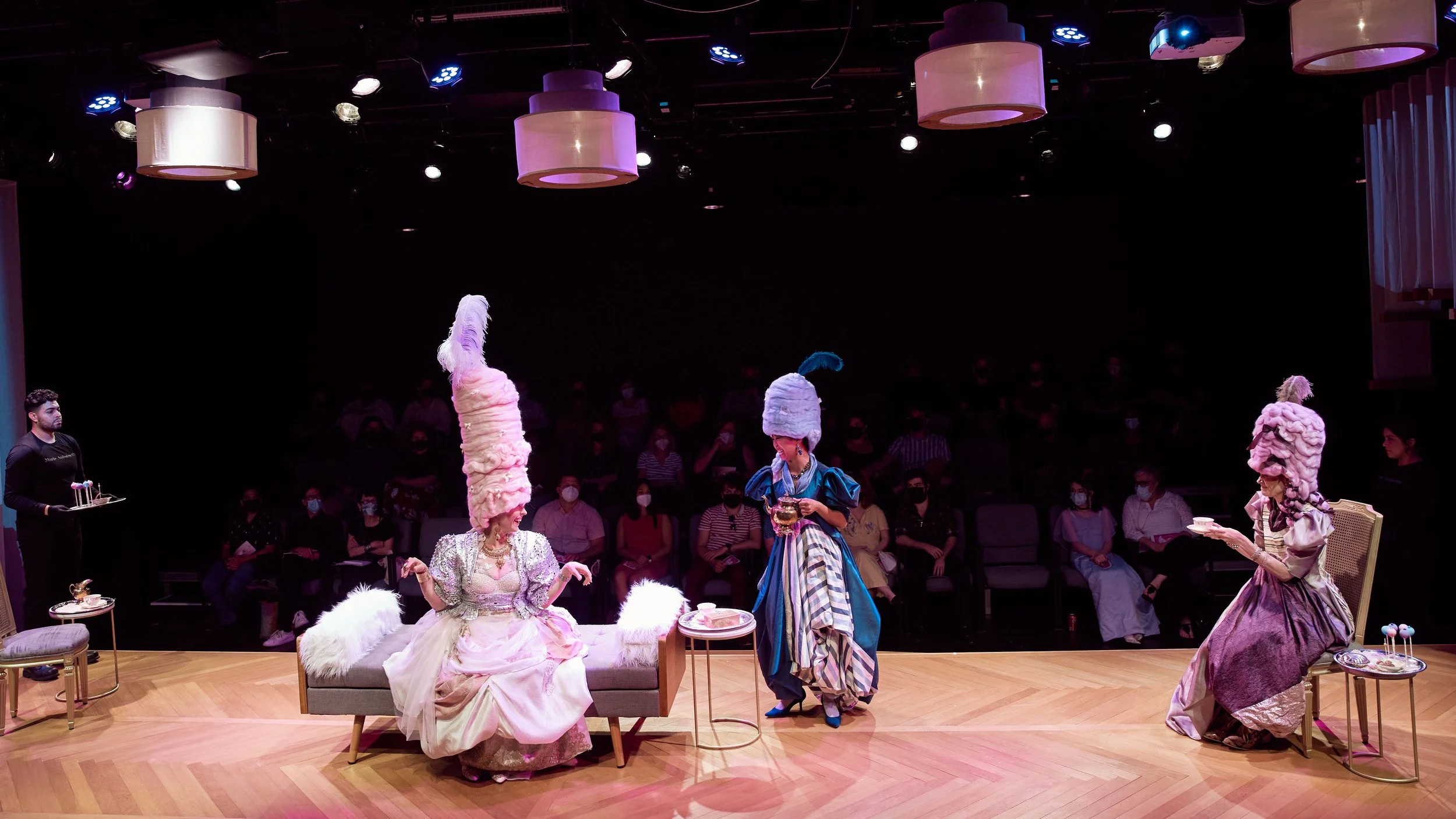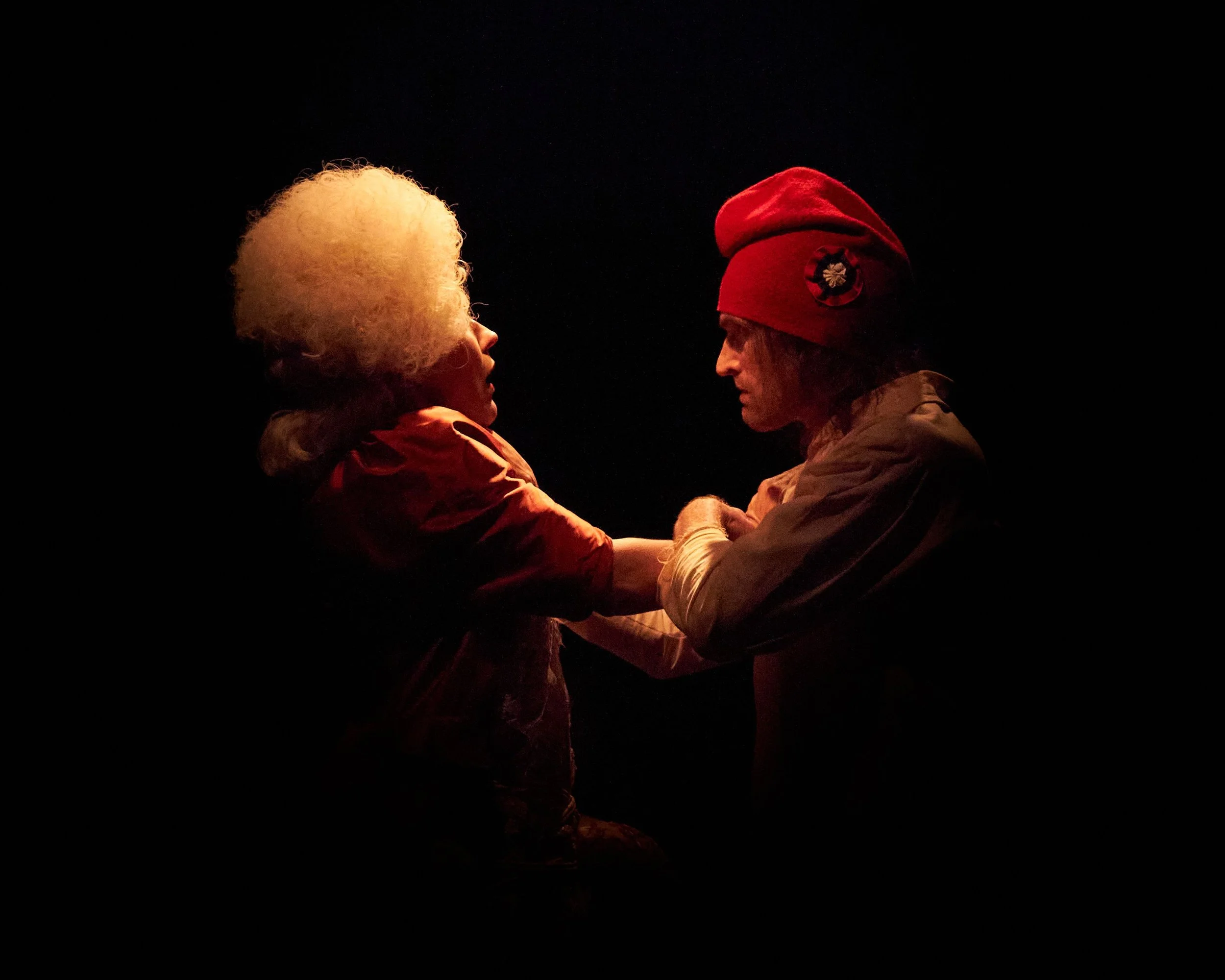Marie Antoinette @ Amphibian Stage
—Jill Sweeney
Much like our cultural obsession with Marilyn Monroe, Marie Antoinette, the doomed, ditzy Queen of France whose callous frivolity spurred her people to drag her to the guillotine (or so the history books tell us), is a seemingly endless source of fascination. Did the royal fashionista make her own fate, or was she merely a hapless puppet, her strings pulled by powerful forces beyond her control? Playwright David Adjmi’s Marie Antoinette, which he describes in interviews as an “expressionist, screwball tragedy,” strives for a balanced take that is at once strikingly personal but powerfully political. Amphibian Stage’s production may look like a patisserie window—candy-colored and exquisitely detailed—but these sweets have a surprisingly complex center.
We find Marie (Allison Pistorius) a few years into her queenship in 1776—bored, jaded, and longing for something more, even if she can’t put her finger on what that might be. She’s also at her most fashionably excessive, sporting glittering layers and a towering four-foot pink wig. (The show’s costumes, from designer and visual artist Laura Anderson Barbata, are appropriately stunning.) She and husband Louis XVI (Mitchell Stevens) are childless due to a little bedroom issue on Louis’ part; the peasants are revolting (oh, and they’re rebelling too); and scandalous rumors about Marie are flying. Years pass, and even as Marie makes strides towards improvement (spending less, introspect-ing more), the animus towards her and her husband grows, and destiny in the shape of a guillotine’s shadow is always at her heels.
Adjmi’s play—written in a mere seven days in a fit of inspiration at an artist’s retreat—is sharp, if a little scattered at times, and could use some tightening of its screws. Marie’s preoccupation with whether she is a “real” person is given little to push against, as none of the characters around her are written strongly enough to create much of a contrast, and the pacing, especially in the first act, sometimes lags.
But it’s hard to imagine anyone better suited to ground this story than Pistorius, who deftly blends comedy and pathos to create a character whose sharp edges are never softened completely, but who you can’t help but pity. Her voice is pure Valley Girl/vocal fry to begin with, and her hands are always in motion, emphatically presentational in public, or wrung in moments of distress. The maturation of the character is masterful, owing not only to Pistorius’ skill but to director Jay Duffer, whose measured direction keeps things moving at a good clip while still giving Pistorius the space she needs to peel off the character’s many layers (explicitly echoed by Barbata’s costume design).
The rest of the cast is an embarrassment of riches, down to the black-clad crew members. Stephens’ Louis is a childlike figure, given to fits of crying and tantrums when he doesn’t get his way. But by play’s end, Stephens manages to imbue the king with warmth, even a little dignity in his final moments. Garret Storms shines playing multiple revolutionaries: while his smug, callous guard character prompted chuckles, his quiet, almost timid moments cutting Marie’s hair before her execution felt wildly counterintuitive, and devastatingly effective. In a part whose significance I’m still parsing, Evan Michael Woods gives a slightly deranged (in the best sense) performance as a sheep who acts as Marie’s confidant. You just have to see it. Felicia Bertch (Therese de Lamballe& Royalist) and Monalisa Amidar (Yolande de Polignac & Mrs. Sauce) give nicely contrasted performances as court “friends” of Marie, and Jim Jorgensen uses his stern looks and stentorian voice to great effect as Marie’s brother Joseph (that would be the Holy Roman Emperor Joseph II).
There’s more than a whiff of ‘90s-era Fashion Week to the production design, from the runway-like center stage to the white and silver accents— even down to the font on the projections that center us in these historical events. The lighting and sound design (from David Lanza and Adam Chamberlin) work well in tandem to convey the court’s fashionable excesses as well as the growing threat from outside the palace. One quibble, or perhaps question, I still have: there are moments where Marie freezes in thought, emphasized by lighting and sound elements, before she snaps out of them. What these episodes are meant to convey is a little opaque. Is she following an unpleasant train of thought and wrenching away from it? Experiencing flashes that foreshadow her death? Or…is the entire play her life flashing before her eyes in the final moments? They’re jarring (by design, obviously), but conveying the intent may need a little tweaking.
I can’t leave off without praising Barbata’s costuming (and wig design!) one more time. Even aside from Marie’s tour-de-force costumes, there’s an impressive thoughtfulness in the way the other characters’ costumes move through time, starting with the excesses of the 18th century, but developing a much more stripped down, 19th-century style as the play progresses.
Much like the lady herself, if you come in expecting cotton candy from Amphibian’s Marie Antoinette, you may be surprised by the complexity and depth on display. The play doesn’t sugarcoat Marie, but it does ask the important question: Even if she was a thoughtless, frivolous woman lacking in smarts and political savvy, was she ever really given the chance to be anything more?
WHERE: Amphibian Stage, 120 S. Main Street, Fort Worth, TX 76104
WHEN: Through June 26th
WEB: For more info, visit: https://amphibianstage.com/



